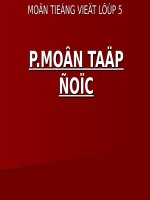Slide Linguistics: Structures syntax
Bạn đang xem bản rút gọn của tài liệu. Xem và tải ngay bản đầy đủ của tài liệu tại đây (140.74 KB, 33 trang )
Linguistics: Structures
Syntax I
2009
Plagiarism at Harvard
• Last year, a Harvard student
accused of plagiarism of a teen
novel
– Sabrina was the brainy Angel. Yet another example of how
every girl had to be one or the other: Pretty or smart
– Moneypenny was the brainy female character. Yet another
example of how every girl had to be one or the other: Smart
or pretty.
• The infinity of syntax gives a
strong hint
Infinity of syntax
• Try typing in Google (in quotes) the first
one, two, three, four … words in today’s
paper.
– A movement hopes to save from demolition
hundreds of buildings built by the Works
Progress Administration. (from
NYTimes.com)
• Virtually every sentence you hear is
new!
Syntax: Combinatorics
• Source of infinity: “infinite use
of finite means”
– Syntax as compression (ZIP files)
– Recursion
• Source of structures
– Phrases, constituents, ambiguity
– Cf. Features, consonants, vowels, onsets, syllables,
words, morphemes, …
Words and Categories
• Syntax is putting words together?
– “The cat meows”
– “The dog barks”
– Cannot memorize all the word combinations
(see Google search)
• Different combinations of words but
same combinations of different words
– “Article Noun Verb”
– Structures again…
Structure Review
• As we saw in our discussion of
phonology and morphology, the
structure is crucially involved in the
function
un lock
able
/k/ /ae/ /t/
What kind of structures
• AB, ABAB, ABABAB, ABABABAB ….
• AB, AABB, AAABBB, AAAABBBB ….
• Which group of patterns is more complex?
• Cognitive science was pretty much launched
by this kind of studies! (AB as linguistic
units)
(AB)n vs. AnBn: syntax is not flat
Syntax
• Structure is critical in syntax;
we will examine two major
points this week
– The notion of phrase; why do some sequences of
words “go together” more than others?
– Movement (Wed): how do we understand the object
of the verb in the following sentences:
John ate several apples.
What did John eat ___?
Structure of Questions
• At a first glance, question
formation in English appears to
involve a rule like ‘move the
auxiliary to the front of the
sentence’:
The cat is on the balcony.
Is the cat __ on the balcony?
Questions, cont.
• This rule is not adequate. In cases
with more than one auxiliary, we
have to know which one is affected:
The cat that is on the balcony is chasing the mouse
Is the cat that is on the balcony __ chasing the mouse?
*Is the cat that __ on the balcony is chasing the mouse?
Complex structures
•
1.
2.
3.
4.
In examples of this type, the point was that the
auxiliary cannot be one that is ‘inside’ a complex
subject. What does this mean? Consider the
following sentences:
John is in the garden.
The boy is in the garden.
The woman with the red hat is in the garden.
The woman with the red hat that John was talking
to yesterday when he went to the store to buy
some batteries for his camera is in the garden
The subject can be arbitrarily long, and it cannot
be broken apart in question formation
Subjects, cont.
• The subjects in the sentences above are all
different from each other
• However, for the purposes of question
formation, they behave in exactly the
same way
• The rule for questions of this type ignores
subjects and their internal structure, treating
them all the same
• Thus the rule cannot be stated linearly; it has
to be stated in terms of a complex
organization of the sentence
Phrases
• Consider again the subjects from the
examples above:
–
–
–
–
John
The boy
The woman with the red hat
The woman with the red hat that John was talking to
yesterday when he went to buy some batteries for his
camera
• In terms of sentence structure, each of these behaves in
the same way. They are grouped under the heading ‘NP’
for ‘Noun Phrase’
• The idea here is that they are phrases that have
properties of the head (John, boy, woman, woman),
independently of other things that might be there
All about the cat
• The head of a phrase defines
its “aboutness”:
– The big cat
– The cat that made a mess
– The cat in the hat
– The hat-wearing cat
– The cat that came back
– The cat that came back in a hat
Phrases, cont.
• Each of these phrases has a
head, where the head is the
important lexical category that
determines the properties of
the phrase:
– Sample VP: [ kick the ball]
– Sample AP: [ proud of his daughter]
– Sample PP: [ in the garden]
Phrases and other phrases
• Phrases can contain other phrases; this
is the property of language that allows
us to start with words etc and assemble
them into larger and larger objects
• Example: Verb Phrase: [kick the ball]
– This VP is headed by the V(erb) kick
– Along with the V kick, we have the NP [the
ball]:
VP
V
kick
NP
the ball
Quiz: Pick out the phrases
•
•
•
•
•
•
in front of the mirror
be patient
drink plenty of
Peter likes
the big bad wolf
kick up a notch
When in doubt …
•
•
•
•
Vertigo(NP)
The third man (NP)
Kill Bill (VP)
On golden pond (PP)
Bend it like Beckham (VP)
Mr. Smith goes to Washington
(S(entence))
• One flew over (*PP)
• When Harry met (*VP)
• It’s a wonderful (*NP)
Even toddlers know that!
for cookies
all gone
that truck
like
sleeping.
Possible truncations
The warm milk is for cookies
The apple juice is all gone
This one is crappy. I want that truck
Kitties like sleeping
Impossible truncations
cookies for.
gone all.
truck that
sleeping like.
Cookie Monster has cookies for supp
Daddy’s gone all the time
I don’t want a truck that small
You are sleeping like a pig
Secrets of baby talk
The milk [is [for cookies]]
The juice [is [all gone]]
I [want [that truck]]
Kitties [like sleeping]
Cookie Monster [has cookies [for supper]] (why
can’t I?)
Daddy’s [gone [all the time]]
I don’t want [a truck [that small]]
You are [sleeping [like a pig]
Tests for adults
• The organization of words and
phrases into larger units involves
the notion of constituent (a unit)
• There are reasons for grouping
some units together but not
others
– Let’s look at some of these reasons
Test 1: Substitution
• The substitution test can be used for other cases as
well; take the prepositional phrases:
• Ok:
– He put it on the table.
– He put it there.
• Not Ok:
– He put it on the table that’s by the door.
– *He put it there that’s by the door.
• The PP in the second example is [on the table that’s by
the door]. Thus there cannot be substituted for the
subpart on the table
Test 2: Movement
• In the next lecture we will look at
movement in detail. For right now, note
that movement is another way of
diagnosing constituent structure:
• Ok:
– I like these apples.
– These apples, I like __
• Not Ok:
– I like the apples that John bought.
– *The apples I like
that John bought.
• Ok:
– The apples that John bought, I like ________
Putting it together
• To this point, we have concentrated on
establishing that words are assembled
into phrases
• Larger units like clauses and sentences
involve hierarchical structures as well
• They involve the arrangement of these
phrases with respect to one another









